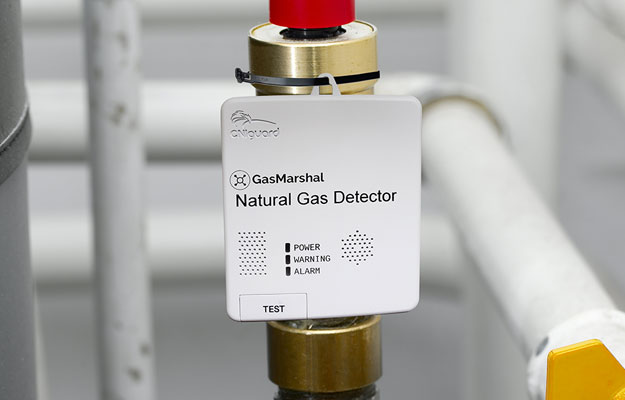
Natural gas predominantly consists of methane (CH4) with small amounts of other hydrocarbons. Before being used commercially for residential or industrial heating and electricity generation, the gas undergoes processing to remove liquid and hydrocarbons to produce pipeline-quality dry natural gas. An artificial odor is added to assist in the detection of leaks. The additive is normally tert-butyl mercaptan with a distinctive smell similar to rotten eggs. Methane gas rises, as it is slightly lighter than air.
There is a flammable gas hazard associated with methane whereby combustion will occur in the presence of oxygen in the air along with a source of ignition. The concentration of the gas in air which will produce a combustible mixture (flammability range) is bounded by an Upper (UEL) and Lower Explosive Limit (LEL). Above the UEL, the mixture is too rich to combust and below the LEL it is too lean. Methane has a UEL of 15% to 17% and LEL of 5% by volume in air.

Natural gas detectors
It is the gas utility company’s responsibility to deliver natural gas to homes and businesses and to maintain the infrastructure up to and including the gas meter at the property. Regulations exist whereby utility companies may be obliged to install natural gas detectors at the boundary of responsibility, but it will always be in the interest of safety to detect leaks, automatically report them to the utility and alert the customer locally. Smart gas valves are becoming more commonly installed in proximity to meters, especially in areas prone to earthquakes. Such valves can automatically turn off the gas supply if seismic activity, fire, water or natural gas itself is externally detected. Communication of alerts to a gas utility can be via LTE-CAT M1, LoRa, Itron or similar low power narrowband wireless networks.
Selecting a natural gas detector for deploying at domestic or commercial premises must take into account the operational life and accuracy of the sensing technology, primary battery life, reliability of communications and ease of installation. Another important factor is the detector’s immunity to general cleaning products and chemicals to eliminate false alarms.
GasMarshal sensor technology
CNIguard’s GasMarshal natural gas detector utilizes cutting-edge, low power Non-Dispersive Infra-Red (NDIR) sensor technology combined with a battery life of up to 10 years. Communication options include LoRa, Itron and NB-IoT. The Sentir manhole monitoring product may also be deployed in vaults or confined spaces with a mercaptan sensing option, which is especially suitable for identifying natural gas leaks in infrastructure not owned by the gas utility.
Find out more about CNIguard’s GasMarshal natural gas detector here.
USA Headquarters
8601 Dunwoody Place
Suite 303
Sandy Springs
GA 30350
United States
T: +1-212-764-0100
Edinburgh Innovation Center
14 S Charlotte Street
Edinburgh EH2 4AX
United Kingdom





 Jason Wilson
Jason Wilson